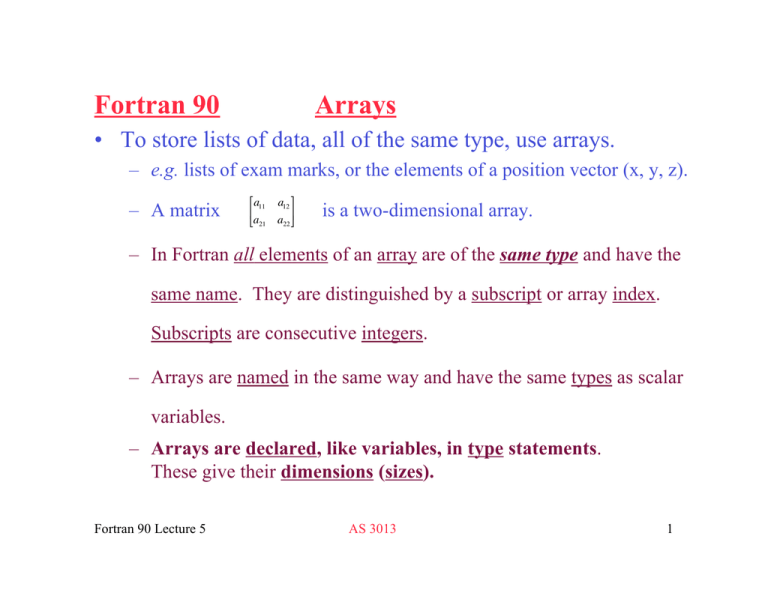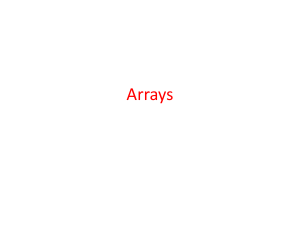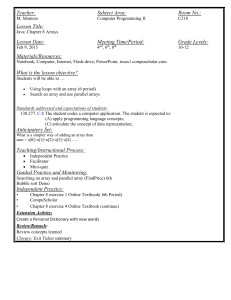Fortran 90 Arrays
advertisement

Fortran 90 Arrays • To store lists of data, all of the same type, use arrays. – e.g. lists of exam marks, or the elements of a position vector (x, y, z). – A matrix is a two-dimensional array. – In Fortran all elements of an array are of the same type and have the same name. They are distinguished by a subscript or array index. Subscripts are consecutive integers. – Arrays are named in the same way and have the same types as scalar variables. – Arrays are declared, like variables, in type statements. These give their dimensions (sizes). Fortran 90 Lecture 5 AS 3013 1 Arrays (cont.) – e.g. REAL, DIMENSION(20) :: L, B REAL, DIMENSION(4,20) :: F DOUBLE PRECISION, DIMENSION(2,3) :: A, B INTEGER, DIMENSION(31) :: Exam_Marks – The first array element is 1, i.e. L(1) to L(20), etc. – You may specifiy the first and last elements (lower and upper bounds) in each array dimension. e.g. REAL, DIMENSION(-5:14) :: L would define L(-5) to L(14). (but generally why bother?) – These declaration statements reserve space in computer memory. – Array sizes must be specified by INTEGER constants. The maximum number of dimensions (rank) is 7. – The shape of an array is a list (1 dimensional array) of the number of elements in each dimension. The SHAPE function gives this. Try PRINT *, SHAPE(array_name). Empty for a scalar. Fortran 90 Lecture 5 AS 3013 2 Arrays (cont.) • Each array element is a variable just like any scalar variable. – Array elements (also known as subscripted variables) may be used anywhere in executable statements where a scalar variable of the same type would be used. – e.g. DOUBLE PRECISION :: S, Y S = X(1) + X(2) + X(3) Y = A(2,1) + B(1,3) X(1) = Y + S – Each subscript may be represented by an INTEGER expression – e.g. INTEGER :: J, K J = 1 S = X(J) + X(J+1) + X(J+2) K = 2 Y = A(K,J) + B(J+K) Fortran 90 Lecture 5 AS 3013 3 Arrays (cont.) • WARNING A computed subscript must be within the declared bounds of each dimension of the array. The compiler cannot check this. If not, an "out of bounds" run-time error may be produced. The Salford compiler has an option which will include code in the compiled program to check the bounds. If run-time checking is not included the program may simply read from or write to some other location in computer memory which could create havoc!! • Another WARNING! Arrays and functions are accessed in the same way so must be declared correctly, arrays with dimensions, subscripts like scalar variables. An undeclared array may be mistaken for a function and produce an incomprehensible error message. Fortran 90 Lecture 5 AS 3013 4 Arrays Named constants in declarations • If you have a lot of arrays of the same or related sizes you can use the PARAMETER attribute to create a named constant to use in array declarations. – INTEGER, PARAMETER :: ISIZE = 100 REAL, DIMENSION(ISIZE) :: ARRAY1, ARRAY2 REAL, DIMENSION(2*ISIZE) :: ARRAY3 – If later you want to change the size of these arrays you only have to change one statement, not many. Fortran 90 Lecture 5 AS 3013 5 Arrays Array constants • An array constructor is a list of constants of the appropriate type between the symbol pairs (/ and /) – e.g. an INTEGER array ARR of size 5 could have its elements set to 1, 2, …, 5 by – ARR = (/ 1, 2, 3, 4, 5 /) – If some, or all, of the elements are related in a regular way we can use an implied DO-loop (same structure as the DO variable control in a DO statement) – e.g ARR = (/ (I,I=2,8,2), 0 /) – The list of values in an array constructor must contain exactly the same number of values as the size of the array to which it is assigned. Fortran 90 Lecture 5 AS 3013 6 Arrays Initializing • Like scalar variables arrays and array elements must be initialized. – In a declaration statement INTEGER, DIMENSION(5) :: & ARR = (/ 1, 3, 6, 7, 9 /) – In an assignment statement ARR = (/ 1, 2, 3, 4, 5 /) – In either case, if all elements of the array are to be set to the same value we may assign a scalar constant ARR = 0 – Set elements individually, for instance using DO-loops for initializing and processing arrays. ARR(1) = 0 – Nested DO-loops can process multi-dimensional arrays. Fortran 90 Lecture 5 AS 3013 7 Arrays Initializing (cont.) – Example: – INTEGER :: I, J REAL, DIMENSION(20) :: FTOTAL REAL, DIMENSION(4,20) :: F DO J = 1,20 FTOTAL(J) = 0. DO I = 1,4 FTOTAL(J) = FTOTAL(J) + F(I,J) END DO PRINT *, J, FTOTAL(J) END DO – This fragment might be a subroutine which has been given the array F containing a table of values and prints the sum of each row (or column) of the table. – In Fortran 90 we could put FTOTAL = 0. outside the loops. Fortran 90 Lecture 5 AS 3013 8 Arrays Input/Output • Consider a matrix operation to solve simultaneous equations – – To read in A and X and print Y REAL, DIMENSION(3) :: X, Y REAL, DIMENSION(3,3) :: A INTEGER :: I, J READ *, A All 9 values in A are read in column order A(1,1), A(2,1), A(3,1), A(1,2), etc. READ *, X will read X(1), X(2), X(3) : Fortran 90 Lecture 5 AS 3013 9 Arrays Input/Output (cont.) – : Y = 0. Clears accumulator DO I = 1,3 DO J = 1,3 Y(I) = Y(I) + A(I,J)*X(J) END DO END DO PRINT *, Y Prints Y(1), Y(2), Y(3) • Fortran always stores by columns - the first subscript varies more rapidly than the second, and so on. • Data in/out Col. 1 Col. 2 etc. Fortran 90 Lecture 5 AS 3013 10 Arrays Input/Output (cont.) • I/O of individual and grouped elements: – e.g READ *, X(1), X(3) – If we print a matrix using PRINT *, A the values will be output as shown, only starting a new line when one is full. A(1,1) A(2,1) A(3,1) A(1,2) A(2,2) A(3,2) A(1,3) A(2,3) A(3,3) • Memory storage works the same way! – Stores by 1st subscript, then 2nd – Important for speed / efficiency Fortran 90 Lecture 5 AS 3013 11 Arrays Input/Output (cont.) – To print the matrix on 3 lines: – DO I = 1,3 PRINT *, (A(I,J), J=1,3) END DO – A(I,1), A(I,2) and A(I,3) will be printed on the same line, equivalent to PRINT *, A(I,1), A(I,2), A(I,3) and so on for J=2 and 3 • Use implied DO-loops to READ 2-dimensional arrays so you can read by rows (not columns). Fortran 90 Lecture 5 AS 3013 12 Arrays Operations • An array element can be used like a scalar variable. – Alter an array element's subscript to make it refer to a different location. • A new, very important feature of Fortran 90: • In Fortran 90 an array can be processed as a single object. – Any operation between two scalar variables can be performed on arrays, provided they are conformable. • Conformable arrays have the same shape – same rank (same number of dimensions) – same extent in each dimension (but upper and lower bounds need not be) • A scalar, including a constant, is conformable with any array. Fortran 90 Lecture 5 AS 3013 13 Arrays – – – – Operations (cont.) Operations are carried out element by element. REAL, DIMENSION(20) :: A, B, C C = A*B Array operation DO I = 1,20 Equivalent explicitly C(I) = A(I)*B(I) on individual elements END DO (old style) All elements operated on by same scalar All elements set to same value. All elements operated on by elemental intrinsic function. – C = 10.*A – B = 5. – C = SIN(A) Fortran 90 Lecture 5 AS 3013 14 Arrays Subprograms • Example: Matrix multiplication is rather common so it would be useful to put it in a reusable subroutine. – PROGRAM MATMLPY_TEST REAL, DIMENSION(3) :: X, Y REAL, DIMENSION(3,3) :: A READ *, A READ *, X CALL MATMLPY(Y, A, X, 3, 3) PRINT *, Y END PROGRAM MATMLPY_TEST – Array names are used as arguments in the subroutine call and the array dimensions (3,3) are automatically passed to the subroutine. Fortran 90 Lecture 5 AS 3013 15 Arrays Subprograms (cont.) – SUBROUTINE MATMLPY(Q, R, P, M, N) INTEGER :: M, N ← Array dimensions Dummy REAL :: P(M), Q(N), R(M,N) variables INTEGER :: I, J Local variables DO I = 1,N Q(I) = 0.0 DO J = 1,M Q(I) = Q(I) + R(I,J)*P(J) END DO END DO END SUBROUTINE MATMLPY – In fact this one is so useful that it's available as an intrinsic function in Fortran 90. Y = MATMUL(A, X) – Function results can be arrays. – Dimensions can be automatically passed to the subprogram. } Fortran 90 Lecture 5 AS 3013 16 Arrays Subprograms (cont.) • Notice how the method was generalized to work with rectangular matrices by passing both dimensions of the array. Fortran 90 Lecture 5 AS 3013 17 Arrays Subprograms (cont.) • Subroutine parameter passing: – Main Subroutine Main INTENT – 3 ⇒ Μ IN – 3 ⇒ Ν IN – address of X ⇒ P IN – " " A ⇒ R IN – " " Y → Q ⇒ Y address OUT – The subroutine doesn't have to reserve space in memory for dummy variables and arrays. The CALL tells it where to find them in the main program space. – The INTENT attribute may be used in dummy argument declarations to show direction of data flow. (Also INOUT) • Limits data flow to one direction (or both) – e.g. INTEGER, INTENT(IN) :: M, N Fortran 90 Lecture 5 AS 3013 18 Arrays Subprograms (cont.) • Array dimensions – May be INTEGER dummy variables and passed as integer expressions (constants or variables). – If array itself is also a dummy argument, as in the example, they must evaluate to values within array dimensions declared in main program. • ie, it has to fit to pass back – Dummy array dimensions may also define completely new arrays in the subprogram. – Often used for temporary work space required by subprogram, amount required depending on arguments passed to it. – Such methods, and others in Fortran 90, allow the re-use of subprograms with different array sizes. Fortran 90 Lecture 5 AS 3013 19 Arrays Memory allocation • Memory for arrays that are not local to a subprogram is allocated by the calling program, ultimately by the main program. • But you may not know the actual size of your datasets, or they may vary. – To change dimensions you must edit source code and recompile. • (Note advantage of PARAMETER attribute.) – OK for small programs, not so good for large ones. • Allocate enough space to handle maximum amount of data. – May not always be needed. : inefficient Fortran 90 Lecture 5 AS 3013 20 Arrays Memory allocation (cont.) Physical dimensions of array Logical dimensions (i.e. what is needed at the time) Depending on how data is organised, you may need to pass both sets of dimensions to subprogram. 1 2 x e.g. array is (7,8), matrix is (3,3) Data in memory is Col 1 Col 2 etc So physical length of column would be needed to access x. Fortran 90 Lecture 5 AS 3013 21 Arrays Memory allocation (cont.) • Trivial example! – Given an integer n and real values x1, x2, … xn, write a program to output the x-values in reverse order xn, xn-1, … x1. Assume n ≤ 1000 – PROGRAM REVERSE INTEGER :: N, I REAL, DIMENSION(1000) :: X READ *, N, (X(I),I=1,N) Implied DO-loop DO I = N,1,-1 for input. PRINT *, X(I) READ *, X would END DO expect 1000 values! END PROGRAM REVERSE – Quite a lot of space in memory may be wasted by dimensioning X to 1000. Fortran 90 Lecture 5 AS 3013 22 Allocatable Arrays • Fortran 90: A better way. – The ALLOCATABLE attribute allows the shape and size of an array to be deferred until run time. – REAL, ALLOCATABLE, DIMENSION(:) :: X READ *, N ALLOCATE( X(N) ) READ *, X – The rank of an allocatable (or deferred-shape) array is specified by the number of colons in the DIMENSION attribute. e.g. REAL, ALLOCATABLE, DIMENSION(:,:) :: Y – The ALLOCATE statement may be used to allocate dimensions to more than one array, e.g. ALLOCATE( X(N), Y(M,N) ) Fortran 90 Lecture 5 AS 3013 23


